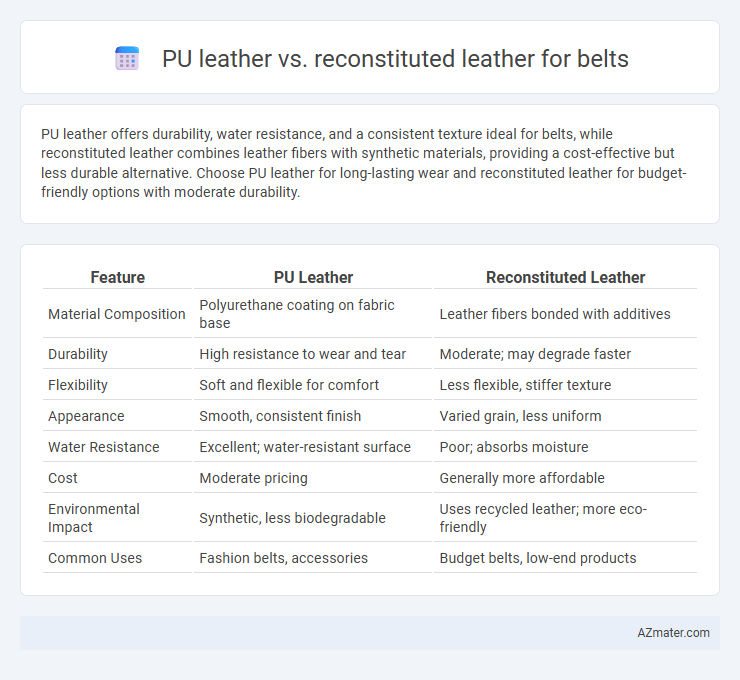PU leather offers durability, water resistance, and a consistent texture ideal for belts, while reconstituted leather combines leather fibers with synthetic materials, providing a cost-effective but less durable alternative. Choose PU leather for long-lasting wear and reconstituted leather for budget-friendly options with moderate durability.
Table of Comparison
| Feature | PU Leather | Reconstituted Leather |
|---|---|---|
| Material Composition | Polyurethane coating on fabric base | Leather fibers bonded with additives |
| Durability | High resistance to wear and tear | Moderate; may degrade faster |
| Flexibility | Soft and flexible for comfort | Less flexible, stiffer texture |
| Appearance | Smooth, consistent finish | Varied grain, less uniform |
| Water Resistance | Excellent; water-resistant surface | Poor; absorbs moisture |
| Cost | Moderate pricing | Generally more affordable |
| Environmental Impact | Synthetic, less biodegradable | Uses recycled leather; more eco-friendly |
| Common Uses | Fashion belts, accessories | Budget belts, low-end products |
Introduction: PU Leather vs Reconstituted Leather Belts
PU leather belts consist of a polyurethane coating layered over a fabric base, offering a durable, flexible, and affordable alternative to genuine leather. Reconstituted leather belts are made by bonding leather scraps with binders and adhesives, creating a material that mimics leather's texture but often lacks the same strength and longevity. Both options provide budget-friendly solutions for belt manufacturing, with PU leather typically delivering greater water resistance and reconstituted leather emphasizing eco-friendly reuse of leather waste.
What Is PU Leather?
PU leather, or polyurethane leather, is a synthetic material made by coating a fabric base with a flexible polyurethane layer, offering the look and feel of genuine leather at a lower cost. This material is breathable, water-resistant, and easier to maintain than reconstituted leather, which is made from shredded leather fibers bonded with adhesives. PU leather belts provide durability and a consistent texture, making them a popular choice for fashion accessories requiring both style and affordability.
What Is Reconstituted Leather?
Reconstituted leather, also known as bonded leather, is produced by shredding genuine leather scraps and fibers, then combining them with adhesives and textiles to form sheets. Unlike PU leather, which is a synthetic material made by coating fabric with polyurethane, reconstituted leather contains actual leather content, offering a balance between authenticity and cost. This material is commonly used in belts to provide a leather-like appearance at a lower price point, though it may lack the durability and breathability of full-grain leather.
Appearance and Texture Comparison
PU leather belts exhibit a smooth, consistent surface with a uniform grain pattern that closely mimics genuine leather, offering a sleek and polished appearance suitable for formal wear. Reconstituted leather belts often feature a coarser texture with visible fiber particles and irregularities, resulting in a more matte finish and a less refined look. The tactile experience of PU leather is generally softer and more flexible, while reconstituted leather feels stiffer and slightly rougher due to its composite material structure.
Durability and Longevity
PU leather belts offer enhanced durability due to their synthetic polyurethane coating, which resists cracking, peeling, and water damage more effectively than reconstituted leather. Reconstituted leather, made from shredded leather fibers bonded with adhesives, tends to wear out faster, showing signs of fraying and stiffness over time. For long-lasting belt performance, PU leather is generally the superior choice, combining flexibility with resistance to everyday wear and tear.
Comfort and Wearability
PU leather offers superior comfort and flexibility for belts due to its polyurethane coating, which mimics natural leather's softness while being lightweight and breathable. Reconstituted leather, made from shredded leather fibers bound with adhesives, tends to be stiffer and less breathable, leading to less comfort during extended wear. For long-term wearability, PU leather belts maintain their shape and resist cracking better than reconstituted leather belts, making PU leather the preferred option for comfort and durability.
Environmental Impact
PU leather, made from a polyurethane coating over a fabric base, has a lower environmental footprint than traditional leather due to reduced animal farming but still involves synthetic chemicals that contribute to pollution and non-biodegradability. Reconstituted leather, created by pulverizing leather scraps mixed with synthetic binders, utilizes waste material and reduces landfill impact, yet the adhesives and processing methods may release VOCs and complicate recycling efforts. Both materials present environmental trade-offs, with PU leather demanding energy-intensive production and reconstituted leather offering waste reduction benefits but limited biodegradability.
Price and Value for Money
PU leather belts offer a budget-friendly option with prices significantly lower than genuine leather, making them ideal for cost-conscious shoppers seeking stylish and durable accessories. Reconstituted leather belts present a middle ground, combining shredded leather fibers with binders that offer better durability and a more authentic leather feel than PU leather, typically at a higher price point. Evaluating value for money, PU leather suits those prioritizing affordability and easy maintenance, while reconstituted leather provides improved longevity and texture that justify its moderate price increase.
Maintenance and Care Tips
PU leather belts require regular cleaning with a damp cloth and occasional conditioning with a silicone-based leather conditioner to maintain flexibility and prevent cracking. Reconstituted leather belts need gentle wiping to avoid damaging the bonded fibers and should be kept away from excessive moisture and heat to preserve their structure. Both materials benefit from storing belts flat or hung to prevent creasing and prolong their lifespan.
Which Leather Type Is Better for Belts?
PU leather offers superior water resistance and consistent texture, making it ideal for belts that require durability and style. Reconstituted leather, composed of leather scraps bonded with adhesives, tends to be less durable and prone to cracking under frequent bending. For belt construction, PU leather is generally the better choice due to its enhanced longevity and uniform appearance.

Infographic: PU leather vs Reconstituted leather for Belt
 azmater.com
azmater.com